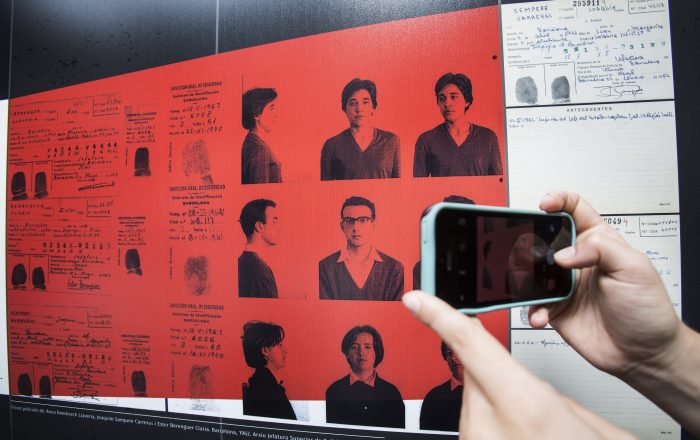- Start
- Programmes
- Evocations of ruins
Evocations of ruins
Dates: 27/09/2016 - 08/01/2017
Venue: El Born CCM
A comprehensive proposal that questions the ethical void created by democratic authorities over the legacies of war and dictatorship
The programme is made up of several parts. Two exhibitions that invite reflection on the conduct of our democracy in managing the Francoist past. One of the exhibitions explains the origins and historical development of three monumental works whose courses and vicissitudes express the ethical void promoted by institutions regarding the past and memories. The second exhibition shows how rights violations committed by the State remained unpunished in this context of forgetting and the ethical void expressed by part of the city’s public art.
Download:
“Franco, Victory, The Republic. Impunity and the urban space” guide
Franco, Victory, The Republic. Impunity and the urban space
18/10/2016 – 08/01/2017
This exhibition sets out to look at the inertia of the Catalan authorities when it comes to Barcelona’s major
monuments to the dictatorship and it does so by reviewing the trials and tribulations of three particular statues –The
Republic; Victory; and the equestrian statue of Franco–, how they are related and the mindset of their creators, Josep
Viladomat and Frederic Marès, who worked in support of the Spanish Republic, extolled the Franco regime and
were later honoured by the Democratic system.
The monuments dedicated to the Fascist Victory and the dictator, Franco, remained on display in Barcelona’s
public space well after democracy was restored, for more than 35 years: one at the junction of Passeig de Gràcia
and Avinguda Diagonal, and the other up at the fort of Montjuïc, in a show of contempt for the graves of the
Republicans killed there by firing squad. They were not removed until 2011 and 2008 respectively.
The “Franco, Victory, Republic. Impunity and Public Space” exhibition was opened on 17 October 2016 with
an initial section on Plaça Comercial, at the entrance to El Born CCM, which served as a gateway. The two original
sculptures from the dictatorship were put on display alongside an image of The Republic, which was projected onto
the wall of El Born CCM, like a shadow trampled on by the two major symbols of the dictatorship. Now removed
from the commemorative pedestal that afforded them so much pomp and ceremony, and placed at floor level, the
statues seemed to have lost their rank as a monument extolling the dictatorship and draw attention to the impunity
enjoyed by such symbols for so many years.
The second part of the exhibition, inside El Born CCM, covers the turbulent lives of these statues, in three main
sections and a closing section. The content is made up of evidence that allows visitors to draw their own conclusions,
drawing to a close in a large research space that brings together pictures of the monuments and large-scale images.
Since the equestrian statue of Franco was unveiled, it provoked varying reactions, from performance art to the
hurling of various objects, until the night of 20 October when three people pushed Josep Viladomat’s piece to the
ground. This act of destruction took away the whole meaning of the exterior part of the exhibition and, as a result,
the other pieces were also removed. The events that occurred as a result of the exhibition during its first three days
have now been included in the content.
Curator: Manel Risques.
That happened to me. On torture and impunity (1960-1978)
27/09/2016 – 08/01/2017
The stage for this exhibition is the city of Barcelona. It shows the practice of torture suffered at the hands of government employees during the 1960s and 1970s. During Franco’s time, public order and the regime’s defence of the social and political order was equated with repression. The repressive violence organised by the government was a phenomenon that ran throughout the dictatorship’s organisation, beginning during the Spanish Civil War until the final stages of the regime, ongoing even during Spain’s transition to democracy.
The practice of torture was one of many manifestations of this violence. It was never classified as a crime, nor was there ever a legal context allowing for its investigation or prevention. Its frequent use by members of the police — and in particular by members of the so-called ‘Regional Police Information Brigades’, which were established as the fascist regime’s political police — was systematic, habitual and carried out with impunity during the arrests
of political opponents and trade unionists. These acts were carried out in the remit of a governing decree.
The main characters in the ensemble recounting this history are women and men whose human rights were violated for refusing to accept the condition of subjects, forwanting and struggling to gain citizenship rights and to establish democratic freedoms.
Curator: Javier Tébar.







